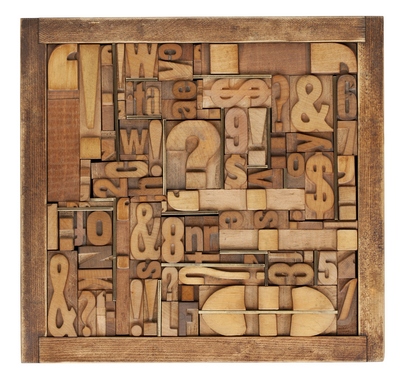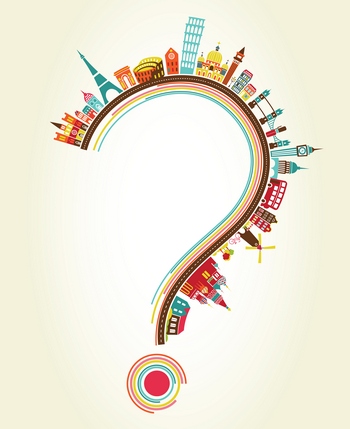Significant little things
 Punctuation marks are an integral part of any language. An ordinary comma can dramatically change the meaning of a sentence: it’s enough to recall the story with “Execute cannot be pardoned.” And the work of translators and editors suggests that they are free to navigate at least two punctuation systems.
Punctuation marks are an integral part of any language. An ordinary comma can dramatically change the meaning of a sentence: it’s enough to recall the story with “Execute cannot be pardoned.” And the work of translators and editors suggests that they are free to navigate at least two punctuation systems. The idea of this post was born when we discussed the translation of the article. In the source material, the percent sign was separated by a space from the number, and it caught my eye - in the Russian text in this case the space is not used (although, nevertheless, the statement is controversial - the experts did not come to a consensus on this issue). Then we decided that we need to talk about this. Specialists of the multilingual localization department interviewed our foreign colleagues and prepared the material that we are now sharing with you. We hope you find it useful.
At the beginning and at the end
Let's see how things are with the punctuation in the sentence: periods, commas, colons, semicolons, question marks and exclamation points.
 We hope that everyone remembers the Russian language - punctuation marks that separate sentences from each other are put only at the end, and that’s the point. If you want to add expression (especially in personal correspondence), combinations of signs are used - "!!!", "?!" etc. In English, German, Italian, French, Canadian, Arabic, and Portuguese, Brazilian dots, dots and their "comrades" live by the same rules.
We hope that everyone remembers the Russian language - punctuation marks that separate sentences from each other are put only at the end, and that’s the point. If you want to add expression (especially in personal correspondence), combinations of signs are used - "!!!", "?!" etc. In English, German, Italian, French, Canadian, Arabic, and Portuguese, Brazilian dots, dots and their "comrades" live by the same rules. Other rules in French: inseparable spaces are placed before the colon, semicolon, exclamation and question marks.
Spanish is the only language in our collection in which punctuation marks frame sentences: at the beginning of the phrase, question and exclamation marks are duplicated in a “slightly” inverted form - “¿” and “¡”.
The most unusual from a European point of view, the Chinese approach to punctuation marks. Their dot is。, the comma is ,, the exclamation mark is -, and the question mark is ?. In the sentence, they behave like Russian counterparts, the only difference is that the Chinese do not put spaces, since all punctuation characters are double-byte. The hieroglyph typed on the keyboard is twice as wide as any letter of the Latin alphabet. Therefore, punctuation marks usually occupy the same space as the hieroglyph. This feature was encountered by those who worked in old IME running DOS, when an incorrectly entered character was removed with two clicks of Backspace. Mostly spaces are used when separating words and characters from other languages, such as English.
Cute features
In Russian, either a hyphen or a dash is used. A hyphen is short, necessary for transferring and combining compound words. The dash is much longer; it serves to separate the semantic parts: different sentences, two parts of one sentence, in dialogs, etc. You can recall all the subtleties of using these signs by looking at the Russian language textbook.
On similar terms, hyphens and dashes exist in English, German, French, and Portuguese Brazilian. At the same time, in the American English dash it is separated on two sides by spaces, and in the British usually it is not:
The lecture - which is the third on this topic this month - will include speakers from different countries. (American English)
The zoo had a great many cats — lions, panthers, tigers, jaguars and cheetahs — which made choosing a favorite very difficult. (British English)
In Spanish, Italian and Arabic, hyphens and dashes look the same: “-”. The Chinese do not use hyphens at all - they only have a dash. Although there are hyphens, long and medium dashes next to letters from the Latin alphabet. A hyphen is short, necessary for transferring and combining compound words. The dash is much longer; it serves to separate the semantic parts
| Languages | Hyphen | Long Dash (Alt 0151) |
| Russian | Yes, to transfer and join compound words | Yes, to separate the semantic parts: different sentences, two parts of one sentence, in dialogs, etc. |
| English american | Yes, to transfer and join compound words | Yes, to separate the semantic parts: different sentences, two parts of one sentence, in dialogs, etc. |
| English british | Yes, to transfer and join compound words | Yes, to separate the semantic parts: different sentences, two parts of one sentence, in dialogs, etc. Not separated by spaces on both sides. |
| Deutsch | Yes, to transfer and join compound words | Yes, to separate the semantic parts: different sentences, two parts of one sentence, in dialogs, etc. |
| French | Yes, to transfer and join compound words | Yes, to separate the semantic parts: different sentences, two parts of one sentence, in dialogs, etc. |
| French canadian | Yes, to transfer and join compound words | Yes, to separate the semantic parts: different sentences, two parts of one sentence, in dialogs, etc. |
| Spanish | Yes, in all cases | - |
| Portuguese Brazilian | Yes, to transfer and join compound words | Yes, to separate the semantic parts: different sentences, two parts of one sentence, in dialogs, etc. |
| Italian | Yes, in all cases | - |
| Arab | Yes, in all cases | - |
| Chinese | Only in the neighborhood with letters from the Latin alphabet | Yes, in all cases |
A pair of letters
 Quotation marks exist in all languages, but look, like national costumes, in different ways. In the Russian language there live both traditional “Christmas trees”, which came from French, and German “paws”, which are used in phrases inside quotes and when writing by hand. In Spanish, Portuguese, Brazilian, Italian, and Arabic, double quotation marks are used.
Quotation marks exist in all languages, but look, like national costumes, in different ways. In the Russian language there live both traditional “Christmas trees”, which came from French, and German “paws”, which are used in phrases inside quotes and when writing by hand. In Spanish, Portuguese, Brazilian, Italian, and Arabic, double quotation marks are used. The English use “single” and “double” quotation marks: the first - for the design of headings, the second - when quoting. Dots and commas are inside quotation marks. There are “Christmas trees” in the French text, with one difference from the Russian one: an inextricable space is put between the beginning of the quoted text and the open quotation mark, as well as between the end of the phrase and the closing quote.
In Chinese, three kinds of quotes coexist, which serve different purposes. Here 《such》 include the names of books, films and other copyrighted works. For all other cases, the Chinese use 「such」. Quotes from the European tradition (whether it be “Christmas trees”, “paws”, “single” or “double”) can only be found in translations or in the neighborhood with phrases from European languages. In traditional Chinese, they have not gained popularity.
Quotation marks exist in all languages, but look, like national costumes, in different ways.
| Languages | "..." | „...“ | “...” | '...' | 《...》 | 「...」 |
| Russian | Standard, dots and commas outside | Alternative in phrase inside quotation marks and when writing by hand | Alternate handwriting | - | - | - |
| English american | - | - | Quotation standard, dots and commas inside | Standard for headings | - | - |
| English british | - | - | Quotation standard, dots and commas inside | Standard for headings | - | - |
| Deutsch | - | Standard | - | - | - | - |
| French | Standard, non-breaking space before opening and closing quotation marks | - | - | - | - | - |
| Spanish | - | - | Standard | - | - | - |
| Portuguese Brazilian | - | - | Standard | - | - | - |
| Italian | - | - | Standard | - | - | - |
| Arab | - | - | Standard | - | - | - |
| Chinese | Only in translations or adjacent to phrases from European languages | Only in translations or adjacent to phrases from European languages | Only in translations or adjacent to phrases from European languages | Only in translations or adjacent to phrases from European languages | Standard for titles of books, films and other copyrighted works | Standard for other cases |
Symbolism
Interest and ppm are also not very standard. In German, French, and Spanish, these characters must be separated by inextricable spaces. And in Russian, English, Italian, Arabic and Portuguese Brazilian to write immediately after the number. Although with the Russian, as we recall, the situation is ambiguous.
Degrees and inches are usually placed after the number without any spaces.
An interesting fact: when the French write large numbers, they separate spaces from three digits with spaces - for example: 987 654 321.12.
The Chinese have their own symbols to indicate degrees (度) and percentages (百分比 and 百分之). However, the familiar ° and% are used along with them, without spaces in front of them.
Set the dialog
The design of dialogs also varies from language to language. In Russian, we put a long dash in front of each line. Portuguese Brazilian speakers do the same.
In English, “double” and “single” quotes are used, for example:
'Here is a million pounds,' said Marina, handing Simon a suitcase.
Marina continued: 'I spoke with Ivan and he said, “Simon is asking for ten million, but that is too much.”'
In German, dialogues are also formed using traditional quotation marks - “paws”. The French put "Christmas trees", as well as short dashes in cases where the author of the replica changes. Parts of the dialogue are beaten off by short dashes in Spanish.
In Italian and Arabic, double straight quotes are used for dialogs.
The Chinese usually put only 「quotation marks」 or their English “counterpart” in their dialogs.
Big or small
 In English, French, Spanish, Portuguese, Brazilian and Italian, everything is simple and familiar to native speakers of Russian - capital letters are used at the beginning of sentences, for abbreviations and proper names.
In English, French, Spanish, Portuguese, Brazilian and Italian, everything is simple and familiar to native speakers of Russian - capital letters are used at the beginning of sentences, for abbreviations and proper names. German is much more fun. With a capital letter, nouns, names and titles are written, a polite form of treatment (Sie) in all case forms (Ihr, Ihre, Ihrer, Ihres, Ihrem, Ihren). Adjectives, participles, and infinitives that are used in a sentence as nouns in combination with a definite (das Gute) or indefinite (ein Lächeln) article, preposition (in Blau), pronoun (dein Stottern), numeral (nichts Aufregendes) or adjective in the declined form (lautes Sprechen). Just :-)
The Arabic alphabet does not distinguish between lowercase and uppercase, but most letters have two, three or four different spellings: for the beginning, middle and end of a word, and sometimes for a separate letter outside the word. A similar situation has developed in the Chinese language - it is unlikely that it will be possible to distinguish lowercase or uppercase hieroglyphs. And if Chinese authors need to highlight some part of the text, then it is emphasized or used in bold.
Bonus
It is funny that many of the native speakers of the European languages surveyed by us noted that they use capital letters according to the same rules that exist in English, but not in such numbers. One of the colleagues surveyed put it this way:
WE TRY NOT TO CAPITALIZE TOO MUCH.
I wonder what that would mean? ;-)
Material from the blog We translate.ru .
PS In our blog has been post authorship 57ded , which may be of interest to those who read this far.
